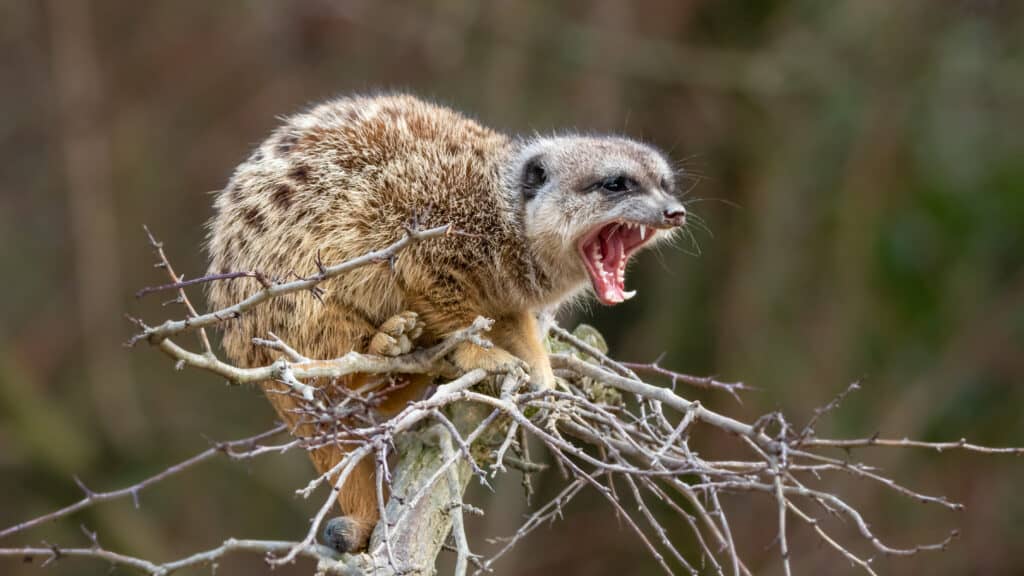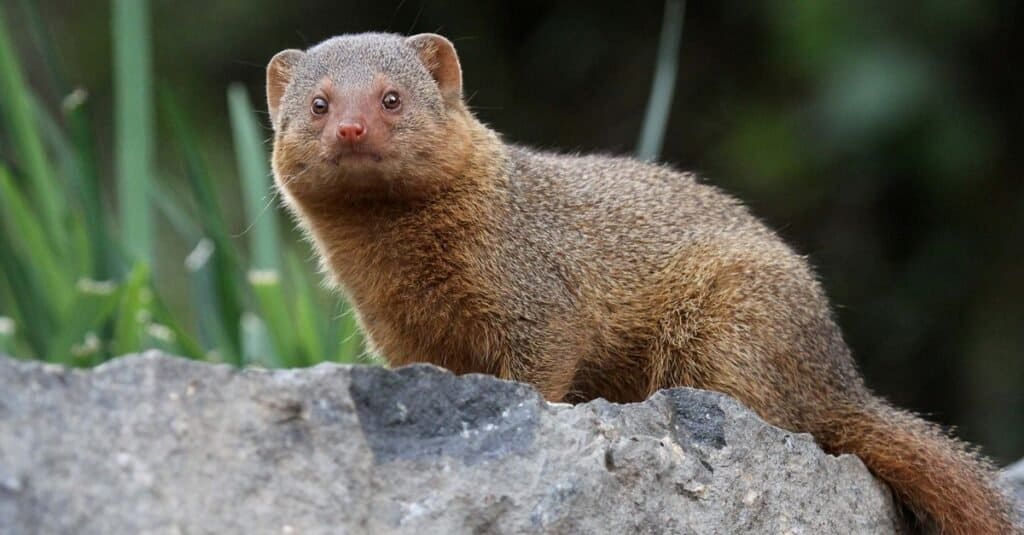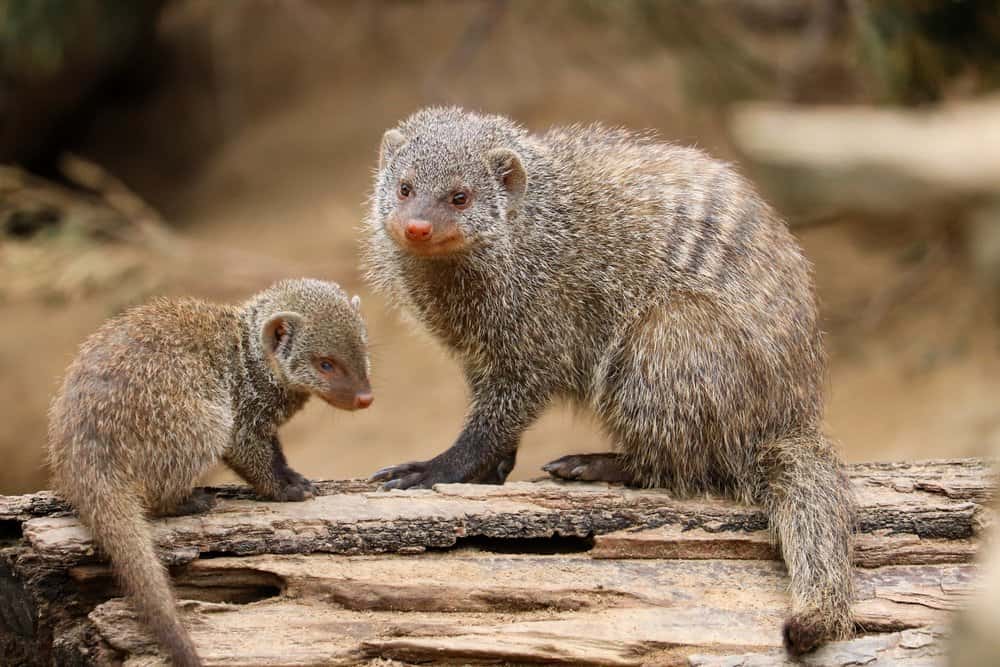The mongoose is a small mammal from the family Herpestidae and genus Herpestes. Scientifically named Helogale parvula, the mongoose is native to the forests and plateaus of Asia and Africa. There are up to 34 living species of the mongoose, and while some build groups to deter predators, others, like the Egyptian mongoose, fancy themselves big enough to stay alone.
One of the most incredible things about mongooses is their ability to hold off predators much bigger than them, including some venomous snake species. They are also mostly carnivorous and possess teeth that help in the consumption of their very diverse diet. In this article, we delve into more details about the mongoose’s teeth. Let’s get started.
How Many Teeth Do Mongooses Have?

MartinJGruber/Shutterstock.com
Mongooses have a strong dentition numbering between 28 to 40, depending on the species. Slender mongooses are some of the most popular mongooses. They have 28 teeth and a dental formula of 3142/3132. Some other kinds like the Indian gray mongoose and the Egyptian mongoose have up to 40 teeth.
Their teeth are composed of carnassial, fang-like canines and premolar teeth. Truth is, composition differs among different genera of the mongoose. The canines are usually the largest; shaped like fangs, they are used for holding down prey before tearing it apart. They can also be used offensively or defensively depending on whatever predatory situation they are faced with.
The premolar teeth, part of the carnassial, are usually thick and they are useful for pulverizing hard shells. The carnassial, as a whole, is used for tearing flesh and bones in a shear-like manner, which explains why they are sometimes called shearing teeth. They also have very long, needle-like incisors that are capable of puncturing and breaking bones.
Do Mongooses Chew?
Besides tearing down their prey, mongooses also use their teeth to chew the resultant pieces of meat and savor the taste, just like humans do.
Also, while they are mostly carnivorous, mongooses also have a herbivorous side and may choose to feed on plants which of course, requires some chewing.
Do Mongooses Bite?
Having examined the sheer sharpness and incisiveness of the mongoose’s teeth, it would be a total waste if they didn’t bite, wouldn’t it? As you probably guessed already, mongooses are naturally equipped to bite and they do, whether they are on the offense against prey or defending themselves against predators. They are known for biting off their prey’s heads to destabilize them before moving to other parts.
While there are no exact numbers for the mongoose’s bite force, they are powerful predators and can even hold their own against some snake species including the king cobra.
What Animals Do Mongooses Hunt?

steve bushman/Shutterstock.com
Mongooses are correctly classified as omnivorous because they sometimes feed on plants, seeds, and fruits. However, their carnivorous side is more dominant as they spend much of their time hunting down prey including rodents, insects, fish, birds, reptiles, crabs, worms, and snakes.
When hunting other animals, mongooses have an age-long habit of biting down on the prey’s head. They may also hunt in packs if they are faced with large prey or want to steal dead meat from other animals.
Experts regard them as “opportunistic” which means they will typically eat most edible things that come their way. They are skilled and formidable hunters and demonstrate some of their most impressive exploits when faced with venomous snakes.
How Do Mongooses Defeat Venomous Snakes?
Mongooses do not have a threatening physical appearance when compared to some other mammals. However, they possess a set of teeth that are sharp enough to combat even venomous snakes. Question is, “how do they manage this?”
The mongoose almost always beats snakes of any kind by deploying a simple but skillful technique. When in combat, the mongoose relies on its speed and agility, baits the snake into attacking, and dodges the snake’s strikes until the snake gets tired. Within seconds, it dives in and bites down on the snake’s head.
Mongooses also possess a thick fur that forestalls bite attacks. Also, when snakes inflict venom during combat, mongooses have mutated cells that prevent venom from entering their bloodstream. Some experts recognize these as acetylcholine receptors and these receptors practically make them immune to a wide range of snake venom.
While mongooses almost always win a fight against snakes, things could go badly for the mongoose, depending on the length and strength of the snake. For instance, a python would likely win a fight against a mongoose.
Nevertheless, mongooses are among the few creatures on earth that can come out unscathed in a fight against venomous snakes.
Are Mongooses Rodents?

Cassidy Te/Shutterstock.com
Given their physical appearance, it’s pretty easy to assume that mongooses are rodents. Their weasel-like appearance has led many into believing they are rodents, which is grossly inaccurate.
Mongooses do not belong to the order Rodentia; rather they belong to the order Carnivora and the family Herpedistae. They are more closely related to cats, dogs, and hyenas than they are to rodents.
Also, rodents characteristically possess a pair of incisors on their lower and upper jaw that doesn’t stop growing and needs constant filing. This is why they often gnaw because if they don’t, the teeth could grow too long and eventually kill them. Mongooses do not have this sort of goofy dentition which further solidifies the fact they are not rodents.
Do Mongooses Attack Humans?
When faced with humans, mongooses will instinctively run away rather than attack. This is because we are much bigger than them and they don’t want any smoke from us. They would only attack if they feel cornered or threatened but that’s usually their last resort rather than a first instinct.
However, rabid mongooses may attack humans and besides the viciousness of their bites, they may also spread rabies and other fatal diseases in the process.
Up Next:
- 10 Incredible Mongoose Facts
- Mongoose vs Ferret: What Are the Differences?
- Mongoose vs Cobra: Who Would Win In A Fight?
The post Mongoose Teeth: Everything You Need To Know appeared first on AZ Animals.
from Animal News, Facts, Rankings, and More! - AZ Animals https://ift.tt/b2cDJo6